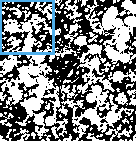 | ||
Lacunarity, from the Latin lacuna meaning "gap" or "lake", is a specialized term in geometry referring to a measure of how patterns, especially fractals, fill space, where patterns having more or larger gaps generally have higher lacunarity. Beyond being an intuitive measure of gappiness, lacunarity can quantify additional features of patterns such as "rotational invariance" and more generally, heterogeneity. This is illustrated in Figure 1 showing three fractal patterns. When rotated 90°, the first two fairly homogeneous patterns do not appear to change, but the third more heterogeneous figure does change and has correspondingly higher lacunarity. The earliest reference to the term in geometry is usually attributed to Mandelbrot, who, in 1983 or perhaps as early as 1977, introduced it as, in essence, an adjunct to fractal analysis. Lacunarity analysis is now used to characterize patterns in a wide variety of fields and has application in multifractal analysis in particular (see Applications).
Contents
Measuring lacunarity
In many patterns or data sets, lacunarity is not readily perceivable or quantifiable, so computer-aided methods have been developed to calculate it. As a measurable quantity, lacunarity is often denoted in scientific literature by the Greek letters
Box counting lacunarity
One well-known method of determining lacunarity for patterns extracted from digital images uses box counting, the same essential algorithm typically used for some types of fractal analysis. Similar to looking at a slide through a microscope with changing levels of magnification, box counting algorithms look at a digital image from many levels of resolution to examine how certain features change with the size of the element used to inspect the image. Basically, the arrangement of pixels is measured using traditionally square (i.e., box-shaped) elements from an arbitrary set of
Calculations from box counting
The data gathered for each
Probability distributions
Alternatively, some methods sort the numbers of pixels counted into a probability distribution having
Interpreting λ {\displaystyle \lambda }
Lacunarity based on
Relationship to the fractal dimension
Lacunarity analyses using the types of values discussed above have shown that data sets extracted from dense fractals, from patterns that change little when rotated, or from patterns that are homogeneous, have low lacunarity, but as these features increase, so generally does lacunarity. In some instances, it has been demonstrated that fractal dimensions and values of lacunarity were correlated, but more recent research has shown that this relationship does not hold for all types of patterns and measures of lacunarity. Indeed, as Mandelbrot originally proposed, lacunarity has been shown to be useful in discerning amongst patterns (e.g., fractals, textures, etc.) that share or have similar fractal dimensions in a variety of scientific fields including neuroscience.
Graphical lacunarity
Other methods of assessing lacunarity from box counting data use the relationship between values of lacunarity (e.g.,
To make the plots for this type of analysis, the data from box counting first have to be transformed as in Equation 9:
This transformation avoids undefined values, which is important because homogeneous images will have
One box counting technique using a "gliding" box calculates lacunarity according to:
Prefactor lacunarity
Another proposed way of assessing lacunarity using box counting, the Prefactor method, is based on the value obtained from box counting for the fractal dimension (
Applications
Below is a list of some fields where lacunarity plays an important role, along with links to relevant research illustrating practical uses of lacunarity.
